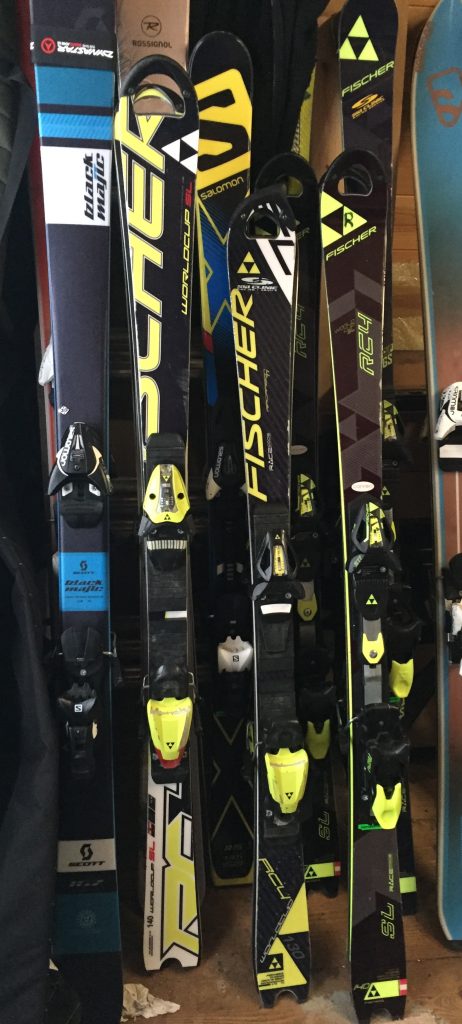Skis are probably the most expensive piece of kit. There are various types of ski on the market, all of which perform slightly different functions, but most SASA racers will have slalom and possibly GS skis, both of which are race type skis. As the racers progress to more high level racing, there are many rules that apply to skis, which we will not attempt to cover here, but you can find out more about at http://gbski.com/rules.php. For artificial slope races, there are no rules for minimum ski length, radius or profile width under or in front of the binding, but it is recommended that the rules for snow are adopted. There are no ski kit rules for U12 and younger.
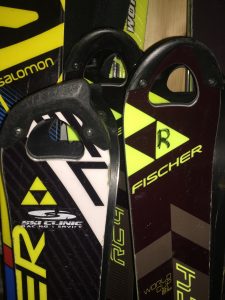 What are the key elements of a race ski?
What are the key elements of a race ski?
A race ski is a stiff ski which will have a curved tip at the front and a flat tail/tip at the back. A race ski needs to hold its edge on tightly packed snow and it needs to be stable at high speeds and making a ski stiff achieves this. The stiffer the ski, the more challenging it is to handle, so you think to think about the weight and ability of the skier when considering ski stiffness.
The ski will be narrow at its waist (the part under the boot) in comparison to the width at the tip and the tail of the ski. This is what creates a short ‘radius’ . The radius measurement, measured in metres, is the radius of the circle that would be drawn if you were to lay the ski flat on an enormous piece of paper and extend the edge outwards. It is effectively the turning circle, and is suggestive of how long it will take the ski to complete the tightest turn possible.
Slalom skis need to be able to turn quickly to get around the gates so a short radius necessary. They are also comparatively short compared to other (racing and non racing) skis.
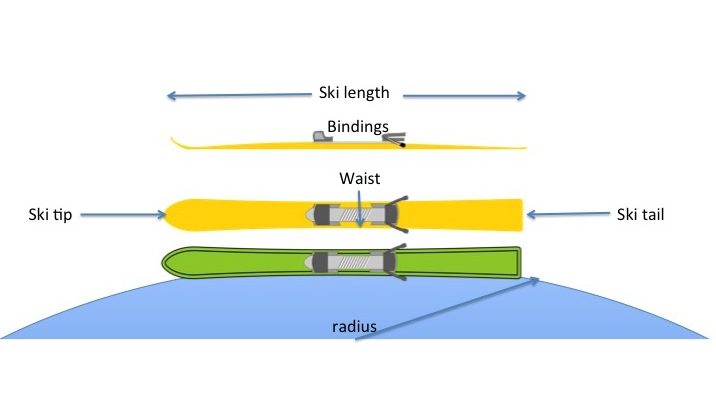
GS skis have a larger radius as GS demands longer radius turns, but still have narrower waists than skis designed for carving rather than fatter, non race skis, which are better for floating on the snow. As GS demands longer turns, the skies can be longer. The increase in length is seen through Super-G to Downhill.
Buying
You are likely to want to buy slalom skis as your first pair of race skis. Slalom skis are quite short and the tips should be between the skier’s chin and nose. Don’t buy slalom skis too long as this will have detrimental effect on your style. It is better to race on skis that are too short, so if you are in between sizes, stay short. GS skis need to be longer and the tips should be between head height and up to 10cm above. How much over your head you can go depends on the skier’s weight and ability.
If you want to buy new, as well as the suppliers mentioned already, bargains can often be found on European retailers such as Glisshop www.glisshop.co.uk and Conrad Sports http://www.sport-conrad.com/en/home/. There are often a lot of similar models of the various skis on offer (they often look very similar), making it difficult to easily distinguish between them, but as a broad rule of thumb, junior slalom and GS skis will be a minimum 130cm. Expect to pay (very roughly) £350 upwards for this year’s model. When checking prices, take into account whether they are being sold with bindings or not. Shorter than this and these will be likely to be softer skis, which will be much cheaper (up to £200). Softer skis can be bought in longer lengths as well, so don’t go on length alone. These softer skis are perfect for the younger, less experienced children. If you buy from a retailer, they will need to know the boot shell/sole length and the weight and height of the skier for them to fit the bindings and set the DIN.
When looking at junior slalom/GS skis, to distinguish between them, the slalom skis will have ‘SL’ in the product description, ‘GS’ for the GS skis! There are far too many makes and models to list so if you see a pair of skis that you think may be suitable but would like help, ask your coach, one of the committee or a friendly parent at the slope.
Buying second-hand is a good option. If you decide to do this, checkout SkiBay or Racers SkiBay groups on Facebook or ask on the SASA Facebook page (this is true of any kit). When buying second-hand skis, check the bases to see that they are smooth – a few small nicks out of the bases is fine, but beware of any large chunks missing. The edges should not have any large chunks or crinkles/dents in them. The cost of the skis will reflect the amount of edge left. A new edge is about 3mm of metal. The more edge that has been filed away, the cheaper the ski. As a very rough guide, a ski with 50% edge remaining should sell for a third of its price when new. The tops of the skis are not a particular factor in the overall condition of the ski, though avoid any skis where the top has delaminated.
All skis will require bindings. You will need to know whether the bindings on the ski will fit your boots. If the bindings are on a ‘track’, you will have more flexibility, but fixed bindings can be remounted by a ski servicer (roughly £20-30). The seller should be able to tell you the boot size range of the bindings. Don’t buy if you can’t get this information. It is also worth asking what angle the edges have been sharpened – this is particularly important if you are doing your own servicing.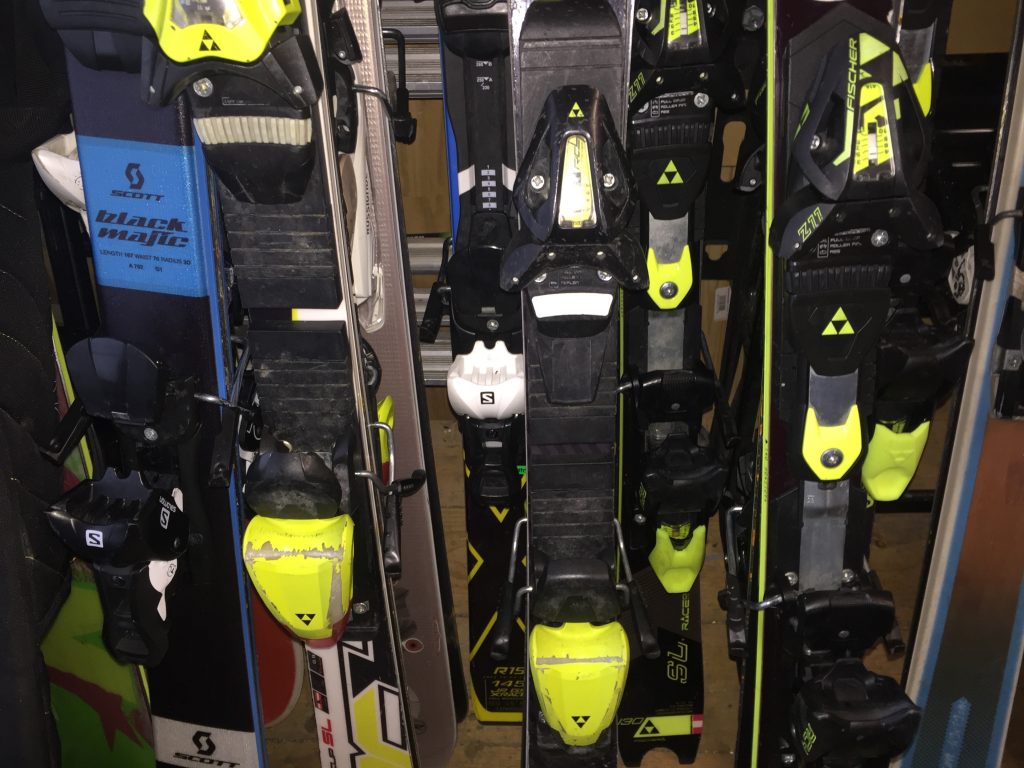
You must also check that the binding will accommodate your required DIN. Your skiing ability, weight, height and boot sole length will determine the bindings’ release force setting (DIN) and there are many DIN calculators available on the internet. Once you have established your DIN, find a binding where your DIN is towards the middle of the binding range .e.g if you have a DIN = 4, go for binding which covers DIN 2.5- 7, rather than DIN 4 – 9, as the bindings work best in the mid range (there is some debate about the accuracy and effectiveness at the end of the ranges, so best to avoid providing evidence to the debate!)
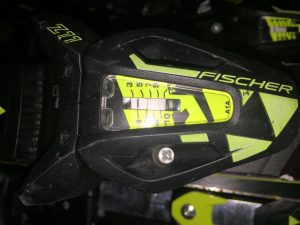
Before using any skis (new or second-hand), for the first time, remember to check the DIN settings and that the bindings provide the correct forward pressure. It is vital that these are set correctly, so that the ski comes off when it needs to and stays on when it should. Information on the binding forward pressure is also freely available on the internet.
Poles are a lot easier! You don’t need specific poles but race poles can be straight as used in slalom racing. or with a ‘kink’ in them for GS. Particularly, when you are starting to move into GS, it is fine to use your slalom poles. To work out whether a pole is a good fit, turn it upside down and hold it under the basket. If your forearm is horizontal, it’s a good fit.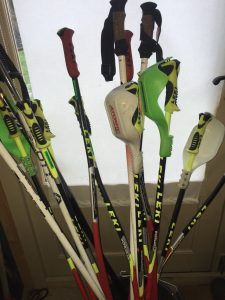
Poles come with either a strap or a ‘trigger’ system, which requires a special glove or strap that fits over normal gloves. Basic (no trigger) poles are relatively cheap (under £20) and these are very easy to pick up second-hand. Many of the racers at SASA like the trigger poles, but this doesn’t necessarily give them the skiing edge!
Care
Basic ski servicing is covered elsewhere, but if you nothing else, make sure that you use ski ties to hold the skis together when transporting them to stop the bases rubbing together and check the bindings (particularly on track bindings which may get knocked) and DIN settings regularly.
Make sure that the poles straps are not broken and that the baskets are on the poles. Racers require ‘bungs’ on their poles when racing on the dry slope. These can be bought from any of the racing suppliers or SASA sells them at races.
